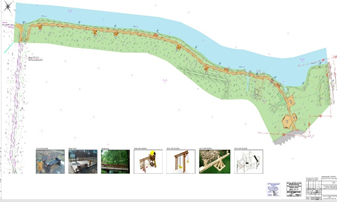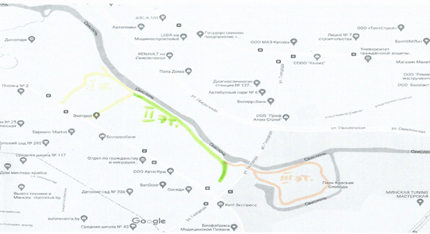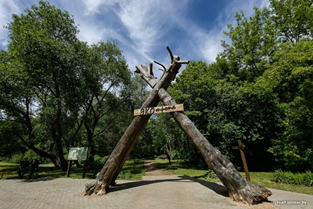The Eco-Trail Chizhovka
The Humanitarian project of
The State Enterprise “ACC Zavodskoy District of Minsk”
Co-financing of the humanitarian project
1. The title of the project: “The Eco-Trail Chizhovka”
2. The project duration: 18 months
3. The applicant organization of the project: The State Enterprise “ACC Zavodskoy District of Minsk”
4. Purposes of the project: Ecological trail “Chizhovka” was opened on June 5, 2018. The route of the trail, 772 m long, is laid along the already established road and path network, passes through objects of nature conservation and aesthetic value. Snakes live here, rare species of birds nest, and plants grow which are listed in the Red Book of the Republic of Belarus. There are 5 viewing places with information stands and places for the rest along the trail.
Since its opening, the ecological trail has been very popular with students and their parents. So, during the summer, autumn and spring holidays, a number of events were held. The main activities of students during walking along the ecological path are games, experiment, observation.
In 2020, the second stage of the eco-trail was opened. The new area covering 615 m., is located on the crossing of Uborevich St. and Goloded St.
This area includes:
- The entrance group in the form of an arch which is made of dry tree trunks. Its height is 4.7 m, the width is 3.4 m.
- two playgrounds for children and a quiz maze at the beginning of the trail.
- two footbridges in the lowlands.
- five observation platforms with resting places and information stands, where visitors can find out how long it takes for glass, plastic and cans to decompose, what species of plants and animals are listed in the Red Book, what birds can be heard walking along the trail, what path the water goes from source, to our taps and back.
- three viewing places -terraces of the waterside views of the Svisloch.
- two “pockets” with benches for the rest.
In order to create a single complex of trail network on the boundaries of Uborevich St. – Golodeda St. – Minsk Zoo, adjacent to the Svisloch river, the State enterprise “ACC Zavodskoy district of Minsk” has developed the project “Eco-Trail in Chizhovka” (the facility “Improvement of green areas within the boundaries of Uborevich St. – Golodeda St. – Minsk Zoo adjacent to the Svisloch river with the arrangement of places for recreation, tourism and creation of the eco-trails. Stage III “).
The designed object has a great importance for the conservation of biological and landscape diversity. The planning structures and functional zoning of the territory are linked to the existing natural complex and the nearby buildings. The construction of the facility provides not only relax, but also it forms the interest and care for the surrounding world among the population, in a play form, allowing to children to recognize and get acquainted them with the inhabitants of meadows and rivers, as well as improve their health by means of active movement, both on foot and by bike.
Besides, the concept of using the eco-trail for educational purpose has been developed.
The state enterprise will provide engineering support during the implementation of the project: applying to the relevant organizations for the preparations and collection of the necessary initial permits for the design and construction of the facility, monitoring their receipt, conducting the necessary procurement procedures to select the design and contractor organizations, monitoring the progress development and approval of project documentation, obtaining the necessary conclusions, monitoring the progress of construction and installation works, collecting the necessary certificates and conclusions for putting the facility into operation in the prescribed manner after construction is completed.
5. Objectives planned for implementation within the framework of the project:
- the development of design and estimate documentation with the passage of the necessary approvals and examinations. The design of the facility will be carried out by a design organization determined by the results of the procurement procedure in the prescribed manner and meeting the qualification requirements determined by the tender documents;
- the completion of the creation of the eco-trail (stage 3) in continuation of the sections which already commissioned in 2018 and 2020;
- the equipping with information stands, observation platforms to demonstrate the natural complexes of the river ecosystem, herb-grass-sedge meadow, birdwatching,
- the equipment of places for the rest;
- the arrangement of children’s health-improving and playgrounds.
Construction work of the facility will be carried out by the contracting organization, determined by the results of the procurement procedure in the prescribed manner and meeting the qualification requirements determined by the tender documents.
6. Target group: children, adolescent schoolchildren of 6-18 years old, youth, students – 18-25 years old, adults – 26-64 years old, elderly people, pensioners –
65 years old and older.
7. Brief description of the project activities: The building of hiking trails according to the facility the status of the object, equipment for the birdwatching, places for observing the flora, viewing places , playgrounds with play equipment for children of different ages with the installation of small architectural forms (gazebos, bridges, benches, trash cans).
8. The total funding (in USD): 140,000
incl. donor funds: 100,000
co-financing 40,000
9. The location of the project (region / district, city): Minsk, borders of Uborevich St.- Goloded St. – Minsk Zoo
10. The contact person: Nosko Ignat., The director of the State Enterprise “ACC Zavodskoy District of Minsk”, (017) 299-25-60, uks-z@yandex.ru
Appendix
The concept of using the Eco-trial for educational purpose
1. Relevance of the concept
The need for ecological education is connected with the need to provide
a favorable environment for human life. The quality of the environment influences health – the basic human right and the main goal of the development of civilization. Without the natural background essential for the existence and development of humans, all social issues lose their meaning. That is why ecological education should not only penetrate the structure of educational system, but it should become one of its foundations.
Literature and history are needed to understand the values of culture, natural science is necessary to study the laws of nature, and ecological education is important for the formation of human’s attitude to nature, the determination of the acceptable transformation, learning the specific social and natural laws and standards of behavior, which make further existence and development of human possible.
Recently, more and more often we hear the words “What will be left for future generation?” Our generation must leave clean forests and rivers, air, fertile field to children and grandchildren. The most important means of ecological education and upbringing is the organization of various activities for schoolchildren in the world of nature.
This concept requires the creation of a “study room” outdoors in nature. The Eco-trail is a territory that is specially equipped for educational purposes, where there are conditions for carrying out of a systems of tasks for the students’ guidance in the natural environment. These tasks are completed during excursions and field workshop.
2. Concept problem.
For several years, teachers from Minsk schools have made attempts to create an educational ecological trail. But practice has shown that it is difficult to provide preservation of such a path in urban conditions. The area of the trail make it possible to create the Eco-trail of the city level.
3. The aim and the concept objectives.
The aim: creation of the educational ecological trail as one of the means of ecological education for schoolchildren.
Objectives:
- Map making – route schemes, passports for the educational ecological trail.
- Design and equipment of the stops along the Eco-trail.
- Working-out of the excursion along the trail.
- Guide training
- Publication of booklets
4. Expected results
The creation and functioning of the educational Eco-trail on the territory of the trail.
5. Description of the concept.
The educational Eco-trial will allow pupils to get ecological knowledge through work in the following areas:
- educational work (excursions)
- practice (conducting eco-biological practice)
6. Evaluation criteria of the concept effectiveness.
- Quantitative (number): working out of thematic excursions, involving schools of the city.
- Qualitative (variety of the concept, form) – the design of the route, passports, plan of the excursions along the trail.
7. Analytical and predictive justification.
Ecological education is a process of forming a responsible attitude of schoolchildren to the natural environment. Love to nature does not start itself – it needs to be awakened. Children of school age show care and respect only to the objects of nature they have deep knowledge of, otherwise they have indifferent or even negative attitude. What is the right way to present information about nature to a child, to tell about its secrets, to share information that humanity has accumulated for centuries?
Many years of experience in teaching and upbringing children show that the most important means of ecological education is the organization of various activities for schoolchildren, for example, the creation of the educational Eco-trail.
Educational routes outdoors have been organizing in our country for more than half a century. As a rule, these routes are planned along the most interesting and often unique corners of nature. Nature trails are currently operating in Karelia, the Crimea and the Urals. But still, the educational ecological trail is a modern type of route organization on the area for carrying out educational work on the problems of the environmental protection, creating conditions for teaching people how to behave in the environment. The Eco-trail is a “study room” in natural surrounding. There are a number of requirements for its organization: the choice of the route and its length, objects for excursion.
This concept of an educational environmental trail is designed for pupils and teachers of educational institutions. On this trail teachers will acquire the experience of educational work with children in natural conditions. Pupils can explore natural phenomena and objects, get acquainted with the wealth and a variety of local flora.
The educational environmental trail is created by the children and for the children for their training and education. This is one of the attractive forms of organizing their activities in the system of environmental education and upbringing. If it is organized in a proper way, it allows pupils to discover their creative opportunities, combine mental and physical work.
The organization of trails by schoolchildren gives a teacher the opportunity to create various life situations the solution of which demands a creative approach from teenagers. Independent research work strengthens the relationship of intellectual and emotional knowledge. As a result, the most important personality quality is born – the conviction that relies not only on knowledge, but also on feelings, on the schoolchildren’s life experience. They produce ecologically competent behavior, conscious attitude towards nature.
The training trail created by the children lives its full life only when adult visitors come here. Speaking as guides on the route of the trail, schoolchildren acquire such valuable qualities of a citizen as responsibility and the tendency to work hard. The trail design, care for it and periodic after equipping inure children to socially useful work and careful attitude towards the common heritage.
Thus, the academic territory in the natural environment serves to pupils both as a laboratory and a workshop.
All the work on the creation and subsequent use of the trail is based on a combination of individual, group and mass forms of organization of pupils. Game situations, disputes, contests and competitions are used. The project and research methods of learning are widely used too.
The ecological trail is designed for three categories of visitors:
- teachers and educators;
- senior preschoolers, school pupils;
- parents, vacationers organized in excursion groups.
8. Concept.
Creating of educational and ecological trails helps humanize education. All the knowledge and skills, feelings, beliefs that are formed during classes on the trail, are aimed at solving one of the most humane problems of our time – the optimization of human relations with the natural environment. The content, methods and forms of organization of the educational process on the trail are submitted to this.
The ecological trail is a promising training area, where pupils act as teachers, promoters, workers, where their civilian qualities and active life position are formed. The study of the diversity of wild and cultivated plants directly responds to the fulfillment of the requirements of the biology curriculum.
The correct selection of species, which are the subject of independent learning research of those that are included in the guide story has great importance.
Thus, the implementation of the project will contribute to:
- carrying out effective educational and promotion work on environmental issues;
- formation of the ecologically friendly behavior;
- acquirement of the experience of educational work with children in natural conditions;
- study and observation of natural phenomena and objects by the pupils and finding the topics for future research work.
9. Implementation.
- The development of the plan for project implementation, the analysis of methodical literature and landscape, where the ecological trail will be designed (January – November 2022, selection of ecological trail stops).
- Creating of initiative groups, attracting pupils to the creation of the trail (November 2022, the creation of initiative groups: “Search team”, “Manufactures”, “Artists-designers”, “Guides”; the distribution of responsibilities among groups).
- The work of initiative groups, the manufacture of visual material for the trail designing, the equipping of the trail, writing of reports related to the objects of the environmental trail, guides training (April 2023 – September 2023, creating of the ecological trail).
- Opening of the educational ecological trail “The Path of Miracles”, advertising
of the educational ecological trail “The Path of Miracles”, (September 2023, carrying out events with the involvement of children, parents and teachers).
10. Distribution of information about the concept.
- The involvement of the mass media.
- Advertising of educational environmental trail via booklets.
- Promoting of educational environmental trail at city seminars and scientific seminars of teachers.
 Version for the visually impaired
Version for the visually impaired





